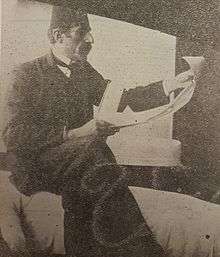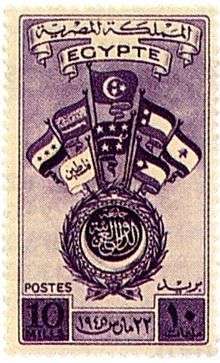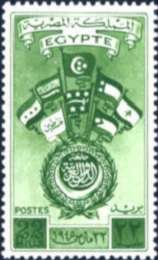Bechara El Khoury
Sheikh Bechara El Khoury (10 August 1890 – 11 January 1964 in Rechmaya)[1] (Arabic: الشيخ بشارة الخوري) was the first post-independence President of Lebanon,[2] holding office from 21 September 1943 to 18 September 1952, apart from an 11-day interruption (11–22 November) in 1943. He had previously served two brief terms as Prime Minister, from 5 May 1927 to 10 August 1928 and from 9 May to 11 October 1929.
His Excellency Sheikh Bechara el Khoury الشيخ بشارة الخوري | |
|---|---|
 Sheikh Bechara El Khoury's Presidential portrait, 1943. | |
| 1st President of Lebanon | |
| In office 22 November 1943 – 18 September 1952 | |
| Prime Minister | Riad Al Solh, Abdul Hamid Karami, Sami as-Solh, Saadi Al Munla, Hussein Al Oweini, Abdallah El-Yafi, Nazem Akkari, Saeb Salam |
| Succeeded by | Camille Chamoun |
| In office 21 September 1943 – 11 November 1943 | |
| Preceded by | Petro Trad |
| Succeeded by | Émile Eddé |
| 2nd Prime Minister of Lebanon | |
| In office 5 May 1927 – 10 August 1928 | |
| Preceded by | Auguste Adib Pacha |
| Succeeded by | Habib Pacha Es-Saad |
| In office 9 May 1929 – 11 October 1929 | |
| Preceded by | Habib Pacha Es-Saad |
| Succeeded by | Émile Eddé |
| Personal details | |
| Born | 10 August 1890 Rechmaya, Aley District, Ottoman Lebanon |
| Died | 11 January 1964 (aged 73) Beirut, Lebanon |
| Political party | Constitutional Bloc |
| Spouse(s) | Laure Shiha |
| Children | Khalil Michel Huguette |

Early life and education
Khoury was born in Rechmaya, to Lebanese Maronite Christian parents in a town in the Aley district, Mount Lebanon governorate on 10 August 1890.[1] He studied law.
Political career
Khoury founded the Constitutional Bloc[3] and served as a Cabinet minister prior to his election as President on 21 September 1943. He was a strong nationalist who opposed the French Mandate, and on 11 November 1943, he was arrested by Free French troops and imprisoned in the Rashaya Tower for eleven days,[2] along with Riad Al Solh (the Prime Minister), Camille Chamoun, and numerous other personalities who were to dominate politics in the generation following independence.
Massive demonstrations forced the Free French forces to release the prisoners, including Khoury, on 22 November 1943, a date now celebrated as Lebanon's national independence day.
Khoury is remembered for his part in drawing up the National Pact, an agreement between Lebanon's Christian and Muslim leaders that forms the basis of the country's constitutional structure today although it was not codified in the Constitution until the Taif Agreement of 1989. Christians accepted Lebanon's affiliation with the Arab League and agreed not to seek French protection, and Muslims agreed to accept the Lebanese state in its present boundaries and promised not to seek unification with neighbouring Syria. The Pact also distributed seats in the National Assembly in a ratio of six Christians to five Muslims, based on the 1932 census, shich has since been modified to represent followers of both religions equally. Most significantly, the three main constitutional offices (President, Prime Minister, and National Assembly Speaker) were respectively assigned to a Maronite Christian, Sunni Muslim, and Shi'a Muslim, Lebanon's three largest confessions, respectively.


Khoury's years in office were marked by great economic growth, but the 1948 Arab-Israeli War in which Lebanon fought on the Arab side strained the Lebanese economy with its financial cost and with the influx of some 100,000 Palestinian refugees. Those factors, along with major corruption in Khoury's administration and presidency, provoked massive demonstrations, which forced him to resign on 18 September 1952. He was succeeded by Camille Chamoun although technically, Fuad Chehab succeeded him temporarily as acting president.
References
- "Khoury, (Cheikh) Béchara (Khalil) El-". Rulers.org. Retrieved 24 July 2012.
- David S. Sorenson (12 November 2009). Global Security Watch—Lebanon: A Reference Handbook: A Reference Handbook. ABC-CLIO. pp. 7–. ISBN 978-0-313-36579-9. Retrieved 16 October 2012.
- A History of the Modern Middle East, 6th Edition, by William L. Cleveland and Martin Bunton, p. 215
See also
- List of Presidents of Lebanon
| Political offices | ||
|---|---|---|
| Preceded by Émile Eddé |
President of Lebanon 1943–1952 |
Succeeded by Fuad Chehab Acting |
| Preceded by Petro Trad |
President of Lebanon 1943 |
Succeeded by Émile Eddé |
| Preceded by Habib Pacha Es-Saad |
Prime Minister of Lebanon 1929 |
Succeeded by Émile Eddé |
| Preceded by Auguste Adib Pacha |
Prime Minister of Lebanon 1927–1928 |
Succeeded by Habib Pacha Es-Saad |